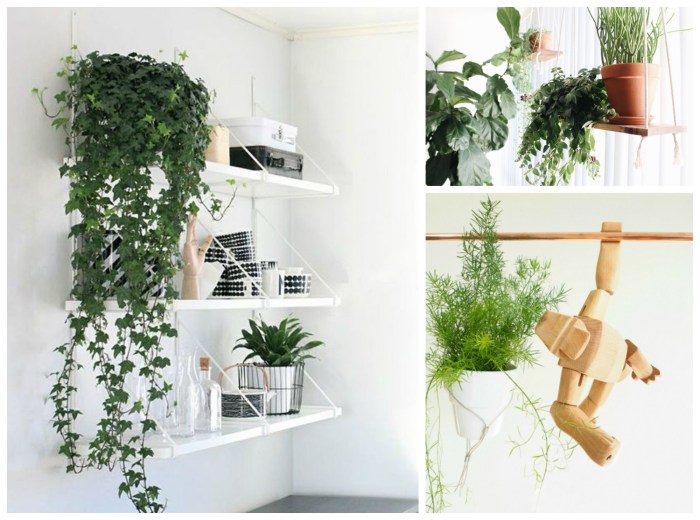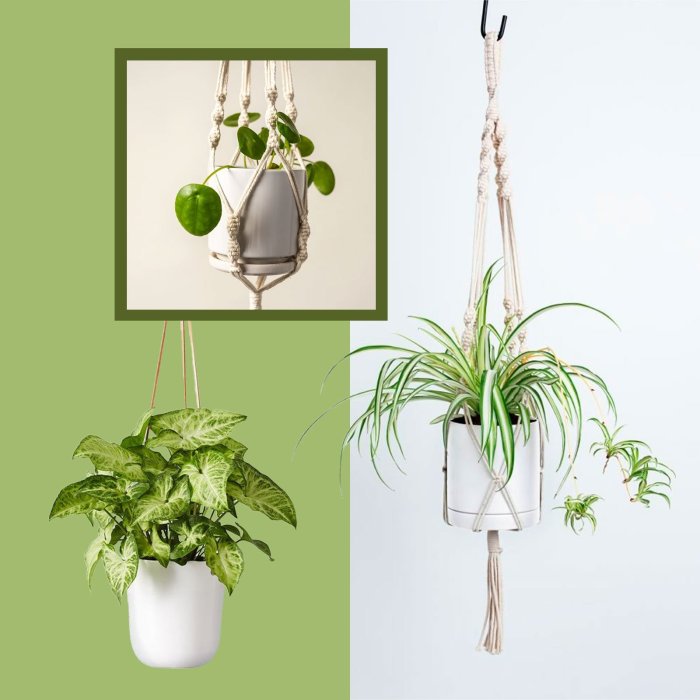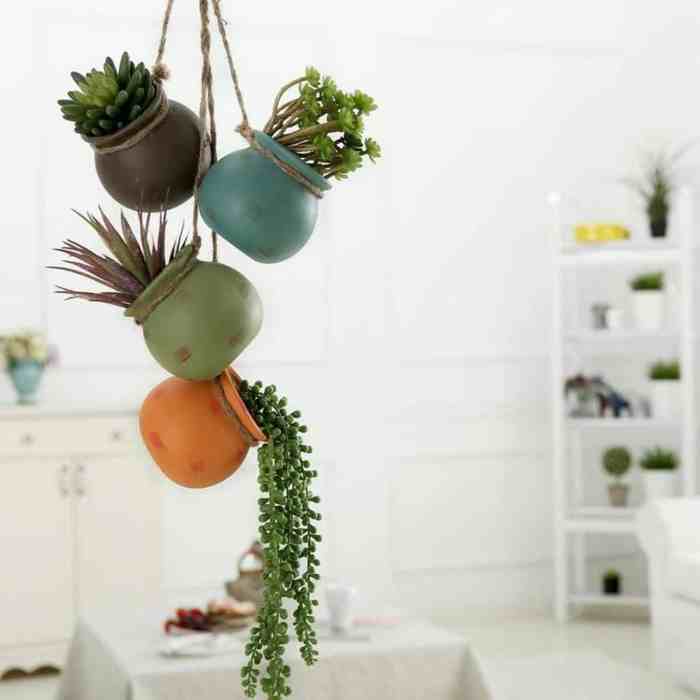Dangly indoor plants are a captivating addition to any living space, offering a touch of nature’s tranquility while purifying the air and reducing stress. From trailing varieties like pothos to cascading ferns and vining monsteras, these plants add a unique charm and aesthetic appeal to your home.
Their diverse growth habits and characteristics make them suitable for various indoor settings. Whether you prefer hanging baskets, macrame plant hangers, or wall-mounted planters, there’s a perfect dangly plant to complement your interior design.
Types of Dangly Indoor Plants
Dangly indoor plants add a touch of elegance and movement to any space. These plants come in various forms, including trailing, cascading, and vining varieties, each with unique characteristics and growth habits.
Trailing Plants
Trailing plants have long, slender stems that cascade down from a pot or basket. They are perfect for adding a touch of greenery to shelves, tables, or windowsills.
- Spider plant( Chlorophytum comosum): A popular trailing plant with long, variegated leaves.
- Burro’s tail( Sedum morganianum): A succulent with fleshy, trailing stems that resemble a donkey’s tail.
- String of pearls( Senecio rowleyanus): A unique trailing plant with tiny, pearl-shaped leaves.
Cascading Plants
Cascading plants have long, flowing stems that hang down from a container. They are ideal for creating a dramatic effect in hanging baskets or on trellises.
- Wandering Jew( Tradescantia zebrina): A fast-growing cascading plant with colorful, variegated leaves.
- Ivy( Hedera helix): A classic cascading plant with glossy, green leaves.
- Pothos( Epipremnum aureum): A popular cascading plant with heart-shaped leaves that come in a variety of colors.
Vining Plants
Vining plants have long, climbing stems that can reach several feet in length. They are perfect for adding height and dimension to a room.
- Philodendron: A large and diverse group of vining plants with a wide variety of leaf shapes and sizes.
- Monstera: A tropical vining plant with large, perforated leaves.
- String of hearts( Ceropegia woodii): A unique vining plant with heart-shaped leaves.
Benefits of Dangly Indoor Plants

Incorporating dangly indoor plants into living spaces offers an array of aesthetic, health, and psychological benefits. These plants add visual interest and texture to rooms, creating a sense of tranquility and connection to nature.
Dangly indoor plants, with their trailing stems and cascading leaves, can add a touch of elegance and greenery to any room. If you’re looking for the best indoor hanging plants that thrive in full sun, look no further than the options available at best indoor hanging plants for full sun . These plants are not only beautiful but also easy to care for, making them a great choice for busy plant parents.
Dangly indoor plants can purify the air, reduce stress, and create a more inviting atmosphere in your home.
Air Purification
- Dangly plants possess the ability to purify the air by absorbing pollutants and releasing oxygen. Studies have shown that certain species, such as spider plants and peace lilies, are particularly effective in removing harmful toxins like formaldehyde and benzene from the air.
Stress Reduction and Mood Enhancement
- Interacting with dangly indoor plants has been linked to reduced stress levels and improved mood. The presence of greenery has a calming effect, helping to create a more relaxing and inviting atmosphere. Studies have also suggested that plants can stimulate creativity and boost productivity.
A Touch of Nature and Tranquility
- Bringing plants indoors brings a touch of nature into living spaces, creating a sense of tranquility and connection to the outdoors. Dangly plants, with their flowing foliage and cascading stems, can add a dynamic and natural element to any room, enhancing its overall ambiance.
Care and Maintenance

Maintaining the health and vitality of dangly indoor plants requires specific care practices tailored to their individual needs. Proper watering, lighting, and humidity levels are crucial, along with suitable potting mix, fertilization, and pruning techniques. Understanding and addressing these care requirements ensures optimal growth and prevents potential issues.
Dangly indoor plants add a touch of greenery and life to any room. Pothos, with its long, trailing vines, is a popular choice for hanging baskets. To ensure the best growth and appearance for your hanging pothos, it’s important to choose the right pot.
Our experts recommend checking out this guide to find the best pot for your hanging pothos. The right pot will provide adequate drainage, support the plant’s weight, and complement the overall aesthetic of your dangly indoor plant display.
Watering
Dangly indoor plants have varying water requirements, depending on the species and growing conditions. Overwatering is a common cause of plant decline, so it’s essential to allow the soil to dry out slightly between waterings. Use room-temperature water and avoid letting the plant sit in waterlogged soil.
Adjust watering frequency based on factors such as pot size, plant size, and humidity levels.
Light
Most dangly indoor plants prefer bright, indirect light. Avoid placing them in direct sunlight, as this can scorch the leaves. If natural light is insufficient, consider supplementing with artificial grow lights to provide the necessary illumination for healthy growth.
Humidity
Dangly indoor plants often thrive in humid environments. Misting the leaves regularly or using a humidifier can help increase humidity levels. Alternatively, grouping plants together can create a microclimate with higher humidity.
Potting Mix, Dangly indoor plants
A well-draining potting mix is essential for dangly indoor plants. A mixture of peat moss, perlite, and vermiculite provides aeration and moisture retention. Choose a pot with drainage holes to prevent waterlogging.
Fertilization
Fertilize dangly indoor plants during the growing season, typically spring and summer. Use a balanced liquid fertilizer diluted to half strength and apply it monthly. Avoid overfertilizing, as this can damage the plant.
Dangly indoor plants have become increasingly popular, adding a touch of nature and style to homes. For bedrooms, hanging plants offer a unique and space-saving solution, creating a serene and inviting atmosphere. These plants can purify the air, reduce stress, and promote better sleep.
Dangly indoor plants, with their trailing vines and lush foliage, are a versatile and low-maintenance way to bring life and freshness to any bedroom.
Pruning
Regular pruning helps maintain the shape and size of dangly indoor plants. Remove dead or damaged leaves and stems. Prune back leggy growth to encourage bushier, fuller plants. Pinch back the tips of stems to promote branching.
Pests and Diseases
Dangly indoor plants can be susceptible to common pests and diseases. Aphids, mealybugs, and spider mites are potential pests. To prevent infestations, regularly inspect plants and quarantine any infected specimens. Treat infestations with insecticidal soap or neem oil. Diseases such as powdery mildew and root rot can also affect these plants.
Provide adequate air circulation and avoid overwatering to minimize disease risk.
Design Ideas and Inspiration

Incorporating dangly indoor plants into interior design can transform a space, adding a touch of nature and creating a sense of tranquility. From hanging baskets to macrame plant hangers and wall-mounted planters, there are endless ways to showcase these plants.
Dangly plants can serve as focal points, drawing attention to a specific area of a room. They can also add height to a space, creating the illusion of a larger room. Additionally, these plants can fill empty spaces, such as corners or unused walls.
Hanging Baskets
Hanging baskets are a classic way to display dangly plants. They can be hung from the ceiling, a wall, or even a shelf. Baskets come in various materials, including wicker, metal, and plastic, allowing for customization to match any decor style.
Macrame Plant Hangers
Macrame plant hangers are a stylish and bohemian way to showcase dangly plants. These hangers are typically made from cotton or jute twine and can be customized in length and design. They add a touch of texture and interest to a room.
Wall-Mounted Planters
Wall-mounted planters are a great option for those who want to save space or create a vertical garden. These planters can be made from various materials, including wood, metal, and ceramic. They can be arranged in different patterns to create a unique and eye-catching display.
DIY Projects and Tutorials: Dangly Indoor Plants

Enhance your home decor with unique and stylish DIY dangly plant holders. From intricate macrame hangers to repurposed containers, unleash your creativity with these step-by-step tutorials.
Discover the joy of crafting and bring a touch of nature indoors with these innovative and budget-friendly DIY projects.
Macrame Hangers
- Gather cotton cords, wooden beads, and scissors.
- Create a lark’s head knot to attach the cords to a metal ring or wooden dowel.
- Follow a macrame knotting pattern, such as square knots or half-hitches.
- Customize the length and design by adjusting the knot sequence and adding beads for embellishment.
Woven Baskets
- Use jute twine, fabric scraps, or yarn.
- Create a base by wrapping the material around a mold or form.
- Interweave the material to form a basket shape.
- Reinforce the basket by adding a lining or using a stiffener like fabric glue.
Repurposed Containers
- Transform old jars, bottles, or cans into unique plant holders.
- Clean and decorate the containers with paint, decoupage, or twine.
- Create drainage holes by drilling or punching small holes in the bottom.
- Hang the containers using wire, twine, or leather cords.
Summary

Incorporating dangly indoor plants into your living space is not only aesthetically pleasing but also beneficial for your well-being. They add a touch of greenery, purify the air, and create a calming atmosphere. With proper care and maintenance, these plants will thrive and continue to enhance your indoor environment for years to come.
Commonly Asked Questions
What are the different types of dangly indoor plants?
Dangly indoor plants include trailing varieties like pothos, cascading plants like ferns, and vining plants like monsteras.
How do dangly indoor plants benefit my health?
Dangly indoor plants can purify the air, reduce stress, and enhance mood by adding a touch of nature to your living space.
How often should I water my dangly indoor plants?
Watering frequency depends on the specific plant species and environmental conditions. Generally, water when the top inch of soil feels dry to the touch.